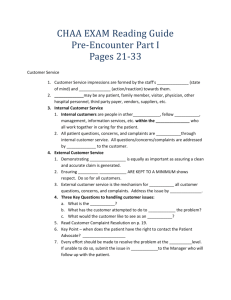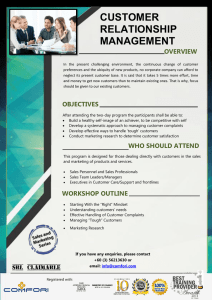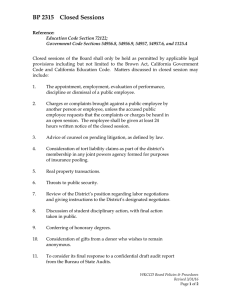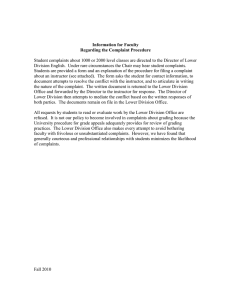Massachusetts Institute of Technology System Design and Management Program
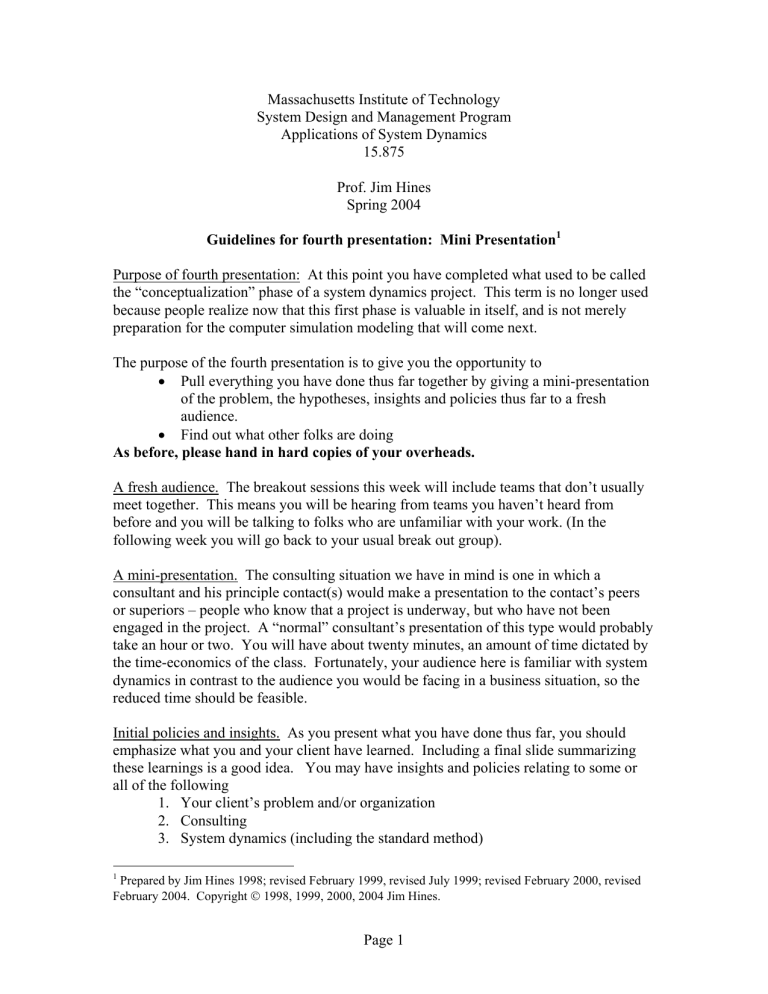
Massachusetts Institute of Technology
System Design and Management Program
Applications of System Dynamics
15.875
Prof. Jim Hines
Spring 2004
Guidelines for fourth presentation: Mini Presentation
1
Purpose of fourth presentation: At this point you have completed what used to be called the “conceptualization” phase of a system dynamics project. This term is no longer used because people realize now that this first phase is valuable in itself, and is not merely preparation for the computer simulation modeling that will come next.
The purpose of the fourth presentation is to give you the opportunity to
•
Pull everything you have done thus far together by giving a mini-presentation of the problem, the hypotheses, insights and policies thus far to a fresh audience.
•
Find out what other folks are doing
As before, please hand in hard copies of your overheads.
A fresh audience. The breakout sessions this week will include teams that don’t usually meet together. This means you will be hearing from teams you haven’t heard from before and you will be talking to folks who are unfamiliar with your work. (In the following week you will go back to your usual break out group).
A mini-presentation. The consulting situation we have in mind is one in which a consultant and his principle contact(s) would make a presentation to the contact’s peers or superiors – people who know that a project is underway, but who have not been engaged in the project. A “normal” consultant’s presentation of this type would probably take an hour or two. You will have about twenty minutes, an amount of time dictated by the time-economics of the class. Fortunately, your audience here is familiar with system dynamics in contrast to the audience you would be facing in a business situation, so the reduced time should be feasible.
Initial policies and insights. As you present what you have done thus far, you should emphasize what you and your client have learned. Including a final slide summarizing these learnings is a good idea. You may have insights and policies relating to some or all of the following
1.
Your client’s problem and/or organization
2.
Consulting
3.
System dynamics (including the standard method)
1
Prepared by Jim Hines 1998; revised February 1999, revised July 1999; revised February 2000, revised
February 2004. Copyright
©
1998, 1999, 2000, 2004 Jim Hines.
Each of these kinds of learnings (or any others!) is fair game for your mini-presentation. a. Insights and policies related to consulting. You may have learned something that relates to consulting. Perhaps you’ve been working with a client who doesn’t possess true “hands-on” knowledge about the problem. In this case you’ve learned something about the kind of knowledge an ideal client ought to have and, hopefully, how to deal with a client who is less than ideal. Or, perhaps you finally had an opportunity to visit a client’s site after spending several weeks in phone-conferences. If so, you might want to present what you’ve learned about the value of face-to-face and on-theground interactions verses the value of phone interactions. b. Insights and policies related to system dynamics. You may well have learned something about system dynamics. Perhaps you never truly understood what a reference mode was. If so, consider explaining what you’d thought before, what you think now and why the difference is important. Perhaps you’ve found that some aspect of the standard method is extremely valuable or extremely detrimental. If so, consider passing along this hard-won wisdom on to your audience. c. Insights and policies related to client’s problem and/or organization. Your insights and policies obviously could relate to what your client is concerned about. For example, if your problem definition hinges on a reference mode showing rising time to market,
Time to Market fear hope
1985 now 2010
Perhaps you would say that from this the client realized for the immediate future, time to market will be determined by prior policies and is beyond their ability to significantly influence. Further, the immediate future won’t reveal which future trajectory they are on. In other words, time to market won’t show the effectiveness of any new policies until a fair amount of time has passed. The client now realizes that an important job of this project will be to identify or create “observables” that react faster than time to market.
If your first loopset concerns the plethora of suggestions coming from customers,
Product complexity loop sales
+ time until next generation
-
+ customers
+ product suggestions product complexity +
Perhaps you would mention that the company could do a better job of filtering and backlogging the suggestions so that (a) only the best suggestions are acted upon and
(b) each release implements a set of interrelated suggestions that can be included efficiently.
If your next loopset expresses the idea that adding programmers is helpful in the sense that “many hands make light the work”, but that a “skill whammy” may lurk in ambush,
Hands and whammy loops productivity and quality
+
time until next generation
-
+
product complexity + sales
+
+ customers revenues
+
+ product suggestions development budget
+ programmers + hiring programmers average programming skill
-
You might observe that this has suggested to your client that training or “doubleteaming” may be important in order for a hiring solution to work.
You would sprinkle these insights throughout your presentation, and your final slide would summarize:
•
Find observable indicators of success or failure
•
Cull customer suggestions
•
Backlog customer suggestions and implement related groups of suggestions
•
Train new programmers
•
Double-team new programmers
You may also have learned something about the client’s organization that is not exactly related to your client’s issue. For example, you may have learned that the organization’s key “blue-sky idea” person has recently retired and that in order to maintain its edge, the company will need to focus soon on finding a way to replace this creative force. One policy might be for the company should take small equity positions in a number of start-up ventures with the idea that your client’s company could buy any startup that shows the ability to come up with innovative product ideas. Or, perhaps you’ve learned that the client culture does resists ideas that come from outside. Or, perhaps you’ve learned something good or bad about the company’s culture. For example, maybe the company has a “blame” or “finger pointing” culture that is getting in the way of uncovering deep causes. In this case perhaps you are thinking about ways of bringing this to your client’s attention in a way he can “hear”. The point here is that if you’ve learned something valuable about the organization, even if that “something” is not directly related to the problem at hand, feel free to present this.
Pulling together what you have done thus far. This presentation should cover
• key reference mode(s) (i.e. problem definition)
•
Hypotheses (i.e. loopsets linked to reference modes)
•
Insights and policies.
You should feel free to reuse any slides you have prepared previously. Ideally, the only new slide you need to prepare is a summary slide of insights and policies. Of course, if you see that modifying prior slides or creating new slides will enhance your presentation, go right ahead. Note that you will not show all of your prior slides, but only the most relevant (e.g. you probably will NOT show your list of variables or your momentum policies).
Example slides
Slide 1
Problem Statement
Nynex’s service quality has been declining in spite of new regulations intended to provide incentives for good service. We want to find policies that will turn the situation around
Service
1985
Now
2005 copyright ©1997,1998 Jim Hines
Slide 2
Nynex: Momentum Policies
Don’t lay people off (Nynex)
Grow faster than the penalties (Nynex)
Reduce rates even more if service stays low (Customers, regulators)
Slide 3
The Spaghetti
Telephone lines
Workforce
Service
Quality
Productivity
Incoming complaints
Unresolved complaints
Resolving complaints morale
Layoffs
Pressure to increase PDY
Profitability
//
Rates
Time until resolved copyright ©1997,1998 Jim Hines
Slide 4
The Rate-Setters’ Error
Service
Service
Quality
-
Incoming complaints
Workforce
+
-
Layoffs
-
Profitability
+
+
Unresolved complaints
Resolving complaints
-
+
Time until resolved
Rates
-
Rates
Workforce
Now 1985 2005 copyright ©1997,1998 Jim Hines
Slide 5
The Rate-Setters’ Solution
Service
Workforce
Layoffs
Service
Quality
Productivity
+
+
Pressure to increase PDY
+
Unresolved complaints
Resolving complaints
-
+
Time until resolved
Profitability
Rates
-
Incoming complaints
Resolution speed
1985 2005
Now copyright ©1997,1998 Jim Hines
Slide 6
Compounding Via Morale
Service
Service
Quality
Incoming complaints
Workforce
Unresolved complaints
Productivity
+ morale
-
Layoffs
-
Pressure to increase PDY
Profitability
+
Rates
Resolving complaints
-
Time until
resolved
Rates
Workforce
1985 Now 2005 copyright ©1997,1998 Jim Hines
Slide 7
The Company’s Solution
Workforce
Service
Quality
-
Incoming complaints
Workforce
+
Productivity
Unresolved complaints
Resolving complaints
-
morale
Layoffs
Pressure to increase PDY
Profitability
//
Rates
Time until resolved
Service
1985 2005
Now copyright ©1997,1998 Jim Hines
Slide 8
The Market’s Solution
Service
Telephone lines
+
-
Service
Quality
+
Incoming complaints
Workforce
Productivity
Unresolved complaints
Resolving complaints morale
Layoffs
Pressure to increase PDY
Profitability
//
Rates
Time until resolved
1985
Now
Phone Lines
2005 copyright ©1997,1998 Jim Hines
Slide 9
The Company’s Hope
+
Telephone lines
+
Service
Quality
Incoming complaints
+
Workforce
Productivity
-
Unresolved complaints
Resolving complaints
morale
-
Layoffs
-
Pressure to increase PDY
Profitability
-
//
Rates
Time until resolved
Phone Lines
Workforce
Service
Now 1985 2005 copyright ©1997,1998 Jim Hines
Slide 10
+
Lurking Danger
Telephone lines
+
+
Service
Quality
Incoming complaints
+
Workforce
Unresolved complaints
Productivity
-
Resolving complaints
+ morale
-
Layoffs
-
Pressure to increase PDY
Profitability
+
-
//
Rates
Time until resolved
-
+
-
1985
Now
Service
2005 copyright ©1997,1998 Jim Hines
Slide 11
Insights and Policies (tentative)
The rate setters’ error
– Reverse current “incentive”?
– Cut different workers?
– Re-categorize complaints?
The rate setters’ solution
– Respond to rate threat by improving quality
– Resist pressure on productivity copyright ©1997,1998 Jim Hines
Slide 12
Insights and Policies (tentative) continued
The Market’s solution
– Monitor more than just complaints or service!
– Put in place a system for spotting a situation of slowing (declining) growth and increasing service copyright ©1997,1998 Jim Hines


